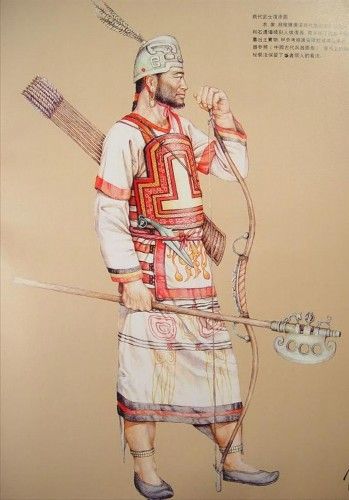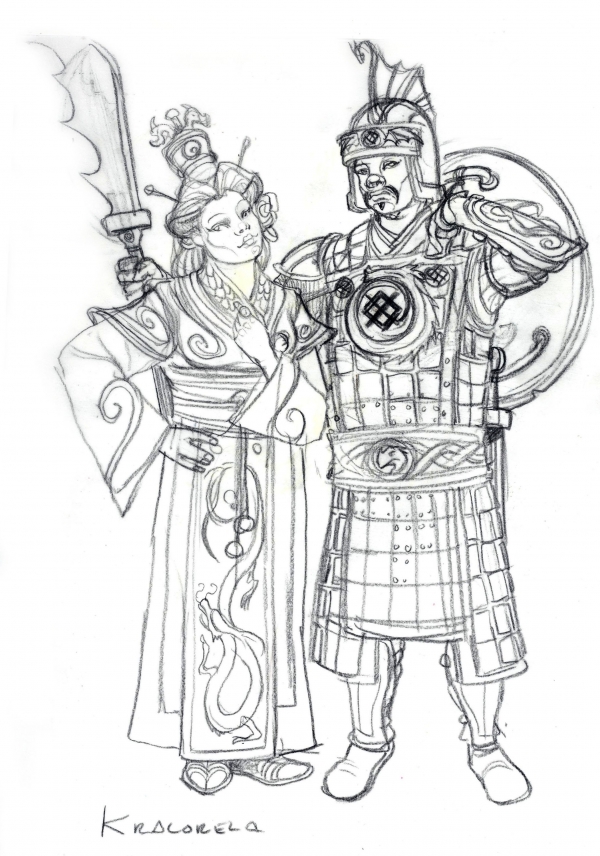Kralorela is a late Bronze Age/early Iron Age civilized empire that claims to have been civilized for 10,000 generations. The inhabitants are xenophobic and dismiss all other cultures as savages. The Kralorelans are ruled by meritocratic scholar bureaucrats and have a Dragon as an emperor. They worship a pantheon of gods and deified emperors, and are noted for their sorcerers, but their most powerful magicians are mystics who transcend the illusory laws of the cosmos through self-discipline and meditative techniques. If you combine Zhou and Han Dynasty China, and claim the emperor is a Draconic Buddha, you won’t be far off.
Most Kralorelans are brown to black-haired, pale to olive skinned, with black eyes being most common (although other colors are not unknown).
Social class in Kralorela is displayed by one’s clothing. Silk is preferred by the wealthy, while the poor make use of cloth made of plant fibres or wool. Mandarins wear long, ornate silk robes with wide-sleeves and a badge indicating the official’s rank and authority. Wealthy merchants wear a narrow-cuffed, knee length tunic tied with a sash, and an ankle-length skirt. Farmers often wear long one-piece tunics or loose homespun wool trousers and a tunic. Headgear is worn by all classes.
Fig. 1: Male Imperial Soldier: The Dragon Empire maintains a large, professional army. Most military units consist of well equipped, trained heavy infantry. Spears and bows or crossbows are the most common weapons for soldiers; officers typically carry swords. Armor is typically lamellar made out of bronze or leather plates or scales, or lacquered plate. Shields are usually made of wood and reinforced by a bronze center and rim.
Our male imperial soldier looks like the this:

On his lacquered breast plate, a Chinese Dragon motif surrounds the Godunya Rune:

Fig. 2. Female Mandarin. Mandarins (hsin tu) serve as the administrative, officers, and spiritual functionaries of the Kralorelan Empire. The mandarins make up a nobility of merit, rather than birth. They must pass the tests of the imperial examination system, and diligently serve as government administrators. Naturally, the son of a mandarin has a much better chance of passing the qualifying exams than does the son of a fisherman.
Our female mandarin has elaborately coiffured black hair held into place with ornate hair-pins: http://www.chinancient.com/wp-content/uploads/2010/06/shang-guan-wan-er-02.jpg. She wears white makeup to keep her skin pale, darkens her eyebrows, and rouges her lips.
She wears a long, ornate silk robes with wide-sleeves (http://pics.livejournal.com/cheungygirl/pic/0005112d ). On her mantle is a richly embroidered badge indicating her rank and authority (like these http://upload.wikimedia.org/wikipedia/commons/2/29/Qing_Dynasty_Mandarin.jpg or http://upload.wikimedia.org/wikipedia/commons/3/33/Bundesarchiv_Bild_134-A313%2C_Tsingtau%2C_Besuch_Hptm_v._Schoeler_in_Yen_tschou_fu.jpg). She is a magistrate-judge, and thus her badge shows two dragons.

And the final

Related Pages
- Art of the Guide to Glorantha
- FAQ about the Guide to Glorantha
- Guide Art Direction – Aldryami
- Guide Art Direction – Mostali
- Guide Art Direction – Orlanthi (2013)
- Guide Art Direction – Pelorian (2013)
- Guide Art Direction – The Seven Faces of Arkat (2013)
- Guide Art Direction – Hsunchen (2013)
- Guide Interview – Greg Stafford (2012)
- Guide Interview – Jeff Richard
- Guide Interview – Mark Rein-Hagen
- Guide Interview – Rob Heinsoo
- Guide Overview – Fonrit
- Guide Overview – Praxian
- Guide Overview – The West
- Guide to the Guide to Glorantha
Page Last updated: 2023-09-23 09:20:54
